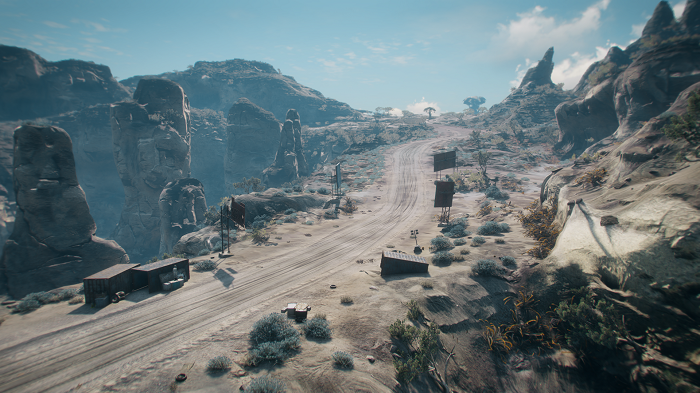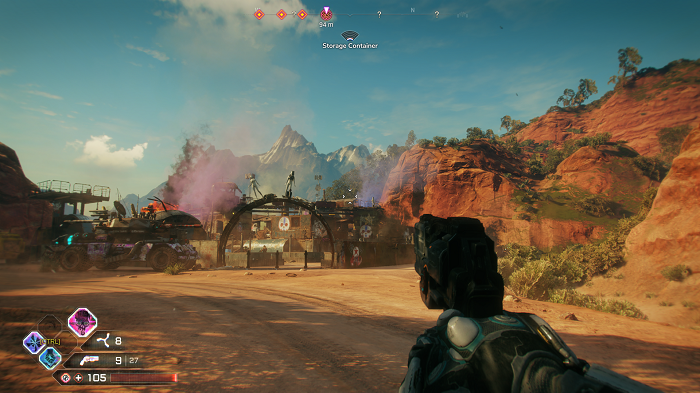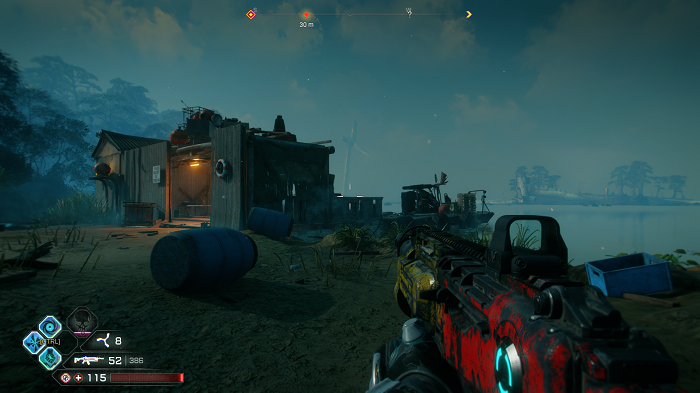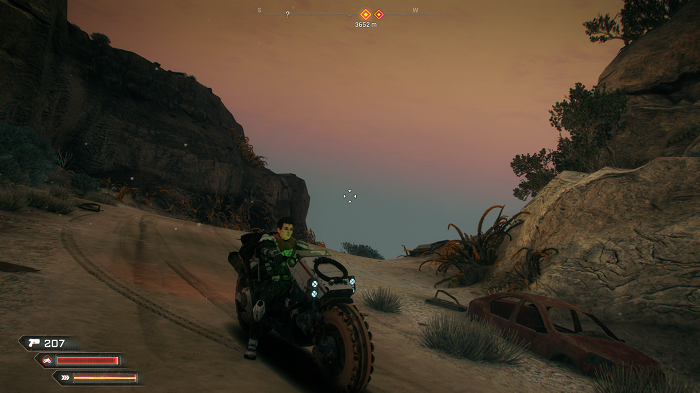|
Rage 2 has been called “the sequel nobody wanted”, and with some justification. Developed by id Software and released in 2011, the original game didn’t exactly set the world on fire. Supposedly, id Software began working on a sequel which was terminated so that the company could focus on the 2016 Doom game. Later, the project was restarted under new management. The Rage 2 that saw release in May 2019 was largely developed by Swedish outfit Avalanche Studios, with the support and supervision of id Software. It also uses Avalanche’s own proprietary APEX engine.
On release, Rage 2 got the dreaded “mixed reviews”. It got a lot of 7 out of 10 scores, which in the demented world of video game scoring is generally taken to mean “this game sucks”. It’s quite possible that critics were increasingly tired of open-world games, and saw little need for a Rage sequel. The game’s structure may also have facilitated rushed playthroughs by critics, which may have kept them from seeing it at its best. Three years on, though, I’ve played Rage 2 for the first time and have been very pleasantly surprised. In fact, there’s a plausible case to be made that this broadly unwanted and unloved sequel is one of the more worthy shooters of recent years. It may have hilariously convoluted upgrade menus, and a thin story, but its core features are very entertaining indeed and it really gets a lot right. This, then, is my case in support of Rage 2 in six easy steps.
Combat-ready
Rage 2 is an open-world shooter, set in a world devastated by the impact of the asteroid 99942 Apophis years earlier. Players take on the role of Walker, last of the Rangers, a group of feared post-apocalyptic lawmen. When the game opens, the cyborg armies of “The Authority”, though defeated in the original game, return to menace the Wasteland. Walker sets out to find a way to combat The Authority, as well as three other enemy factions: the bandit Goon Squad, a horde of mutants, and the enigmatic Immortal Shrouders. As with the first game, the story of Rage 2 is pretty thin and uninvolving. Any shooter lives or dies by its combat, though, and here Avalanche were firing on all cylinders. Invading bandit camps or mutie dens is consistently gripping, because of how visceral and freeform the battles are. As Walker’s arsenal of guns and abilities expands, so too do her options in combat (incidentally, you can also play Walker as a man). Crucially, Avalanche and id Software strongly emphasise aggressiveness. Most weapons in Rage 2 are fairly short-ranged, enemies drop resources that vanish after a few seconds, and building up combos fuels “overdrive”, a special mode which allows Walker to recover health and dish out death even faster. Like the glory kills of the recent Doom games, these ideas combine to create combat where the player is always encouraged to push in, close the distance, and exploit their flashy prowess in style. Despite whatever flaws the game may have, this combat loop is a continual draw which should not be overlooked.
Raider of lost Arks
Before Apophis struck the Earth and destroyed society, the Eden Project - no, not that one - created a series of “Arks” around the world. Many of these contained people in suspended animation, ready to emerge later and to rebuild humanity. In Rage 2, the player seeks out Arks in order to find new weapons and to power up their ranger suit with new “nanotrite” special abilities. They’re a clever and engaging feature of the game, partly because they can mostly be found and exploited in any order. In a conventional FPS, the sequence in which a player acquires weapons, and often abilities, is strictly controlled by the designers. In Rage 2, the Ark system allows players to expand their arsenal in a flexible and often surprising way. Finding a new Ark is always a thrill. They are usually found in interesting, hand-crafted locations and opening one often means winning a tough battle with one or more enemy factions. Defeating a group of foes, then cracking open an Ark to discover a weapon or ability which will permanently change how the game plays is crucial to the rhythm of Rage 2, and a vital part of its appeal. This flexible route to building up the player’s tools is something other open-world shooters could definitely learn from. It’s a shame that each Ark find triggers an excessive, immersion-breaking tutorial sequence but to be fair, these can be turned off.
Tools of the trade
One reason why locating Arks is such a blast is the quality boomsticks that can be found within. Like the more recent Shadow Warrior 3, Rage 2 goes down the route of a small arsenal of just eight weapons. Each one, though, occupies a fairly specific niche and they’re all tremendously entertaining to use. Standard fare like the assault rifle and shotgun are suitably crunchy and satisfying, but the game’s real strength in its killing stick department is the more exotic options. The firestorm revolver, for example, plugs enemies with incandescent projectiles. Initially these do nothing, but the alternate fire has the player character click their fingers and cause all fired projectiles to explode, igniting foes on fire. It’s nearly as glorious as the flare gun from Blood. The grav-dart launcher is even more amusing. It also tags enemies with glowing projectiles; this time, the secondary fire selects a point to which the victims are then violently yanked. This allows all kinds of tricks, like yeeting mutants off cliffs, or high up into the air so that they go splat on their return to Earth.
Road warrior
Avalanche have a lot of experience with driving in open-world games - after all, they’ve developed all four entries in the Just Cause series as well as Mad Max. Somehow, though, they have never quite managed to nail their driving controls. Something has always felt just a bit off about the way vehicles handle in Avalanche’s games, and that extends to Rage 2. That said, the driving aspect of the game is still quite compelling. There are a lot of vehicles to recover or unlock, including an Ark-tech motorcycle and a low-altitude flying machine but by far the most useful is the Phoenix. Given to players at the start of the game, this wheeled war machine is possibly the closest thing to the Landmaster from Damnation Alley that you can drive in a game. By acquiring auto parts, players can upgrade this monster in several ways. It can be fitted with armour-piercing cannons, cruise missiles, and twin mortars. It even has an AI which talks to you from time to time. It's a great means to get from A to B, but the most exciting use for it is definitely hunting down enemy convoys. These roam the Wasteland, and consist of a resource-laden big rig escorted by heavily-armed buggies and bikes. In a sort of reverse Mad Max: Fury Road, players can mount a high-speed assault on these convoys in order to crack them open and steal the goodies inside. Then there is the “King Squasha”, a powered-up convoy truck which serves as a recurring, optional, mobile boss fight.
Wish you were here
One of the common criticisms of Rage 2 was that it has a supposedly uninteresting open world. While I think there are games with genuinely quite boring open worlds (like No More Heroes), and games which don’t use their open world very well (like Mafia II), I don’t think Rage 2 fits into either category. It isn’t exactly bursting with life but it’s a post-asteroid wasteland - what would you expect? The few towns are quite lively, with numerous civilians who all have ludicrous names like “Liz Terrine”, and “Shaniqua Custoblasteroid”. Of the many locations spread out across the six regions, a couple are once-thriving towns which have fallen into the hands of bandits or mutants. Paying attention to the Wasteland, as opposed to just tearing through it as fast as possible - as some of the reviewers in 2019 probably did - reveals a lot of environmental storytelling. Post-apocalyptic settings are ten-a-penny these days but Rage 2 captures the feeling of a truly fallen and deranged society surprisingly well. It’s atmospheric, too - standing by the side of the road and seeing a friendly convoy of armed buggies tear past, their headlights piercing the night, is always absorbing. The many optional locations are all hand-crafted, their treasures hidden in fun and varied ways. It doesn’t absolutely teem with life, and nor should it - but the world of Rage 2 is an intriguing one to explore.
All you can eat
One downside of open-world games is that they can often be absurdly long, requiring players to complete hundreds of increasingly tedious side-quests if they ever want to see the end credits. The numerous games published by Ubisoft suffer strongly from this, as does Avalanche’s own Mad Max. Seemingly as a direct response to this criticism of their earlier game, Rage 2 is structured very differently. The main story is broken up into three “threads” pursued in parallel. Each thread is overseen by a particular character, and each is associated with a few types of activities. For example, Loosum Hagar (who was a minor character in the original Rage) oversees one of the three threads; destroying roadblocks is one activity which helps her out. Pursuing all three threads to completion makes the final mission available - the chance to defeat mechanised masterminds The Authority, permanently do away with villain General Cross, and save the Wasteland. As reviewers pointed out in 2019, this can all be done inside something like 12 hours. Far from being a weakness of Rage 2, it’s a strength. The game’s ending isn’t hidden behind tens of hours of tiresome side-activities. This means that players can play as much or as little of the game as they want, and get the full story and the chance to see its ending. It’s an unusual and very welcome piece of design. Once the story is over, there’s the chance to go back to the Wasteland and pursue whatever side-missions or activities were missed - but crucially, Rage 2 respects the player’s time.
Have your own take on Rage 2? That’s what the comment section is for, Wastelander. Coming up soon will be my monthly roundup of the games I played in April. In the meantime, if you’re interested in Arthur C. Clarke’s take on how an asteroid-induced apocalypse could be avoided, you can read or listen to my review of his 1993 novel The Hammer of God.
0 Comments
Your comment will be posted after it is approved.
Leave a Reply. |
About
Exploring classic science fiction, with a focus on the 1950s to the 1990s. Also contributing to Entertainium, where I regularly review new games. Categories
All
|







